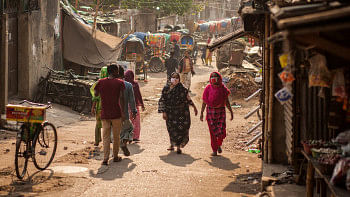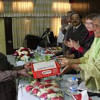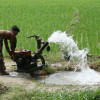Is the family farm disappearing?

In 1899, Kautsky predicted that the peasantry in Russia would be squeezed out of existence by larger-scale capital and that such rural people would become proletarianised labour as the country industrialised. Lenin and Trotsky adopted this stance and in effect sought to hasten the process, supported by Preobrazhensky, but were thwarted by the post-revolutionary food crisis, thus adopting the New Economic Policy instead, which encouraged markets and kulaks producing higher net marketable surplus under quasi-capitalist conditions. The rise of the kulaks as a political force then encouraged Stalin to lead a process of collectivisation, communes and state-enforced targets for surplus grain to the cities. However, resistance to this direction came from Chayanov, who mobilised statistics to demonstrate a distinctive peasant mode of production—drudgery-averse production for immediate family consumption, calibrated to the family's life cycle and changing dependency ratio (workers over consumers within the family) so that additional land from the village authorities could be added to the family farm, with its worker members just working harder to feed its larger numbers. Chayanov ended up in jail for arguing that the farmer (i.e. peasant) should not be separated from this family consumption (subsistence) motive by being forced into collectivisation. Sholokhov's novels, such as Virgin Soil Upturned and Harvest on the Don, vividly tell this story of peasant alienation.
Does any of this apply to present day and future Bangladesh? Yes and no. No, because the availability of additional land to adjust to changing dependency ratios is not just a matter of allocation by the local government, to maintain the integrity of the family farm at the expense of its harder-working members. But yes in the sense that the intrusion of capital into agriculture and the imperative for higher productivity to address national food security have several effects upon agrarian Bangladesh.
We argue in our ongoing investigation into the "Political Economy of Agrarian Futures in Bangladesh" (at BIDS) that the social system of agriculture is undergoing a process of disarticulation (at the family farm level) and rearticulation (at higher levels of aggregation) to accommodate the intrusion of capital and all the other stakeholders and economic actors associated with the process—input suppliers, mechanisation for cultivation and post-harvest operations, marketing of produce, etc. Extended supply and marketing chains, in other words. These days, "agrarian" refers to a wider agricultural system containing machines, variable inputs (high yielding seeds, chemicals), transportation, physical and virtual infrastructure, and services. We would also argue that it includes "rurbanisation" (urbanisation of the rurality) in various forms, greater mobility of labour through fluidity of migration and its commodification as hired labour rather than tied, dependent, subordinate landless labour trapped in the village, and of course new money in the form of remittances either from overseas or domestic. We also note the "hybridity" of labour with expanding non-farm work as well as non-agricultural work to the point that part-time farming is now common.
We suggest that the disarticulation of the family farm unit under these changing conditions will occur in several ways. Our thinking starts from the question: if lumpy machinery like tractors, pump sets and combine harvesters offer prospects of higher productivity and returns to land, then how is a small farmer with scattered, fragmented plots supposed to access those opportunities? From our preliminary field investigations across 10 village locations and other knowledge, we are seeing in the case of orchards and ponds that "owners" bring in "contractors" to manage the resource, paying a fee to owners. We predict that this rentier-contractor model will extend to other crops and land use, especially irri-boro as a high-input, staple crop (and vital for food security), but also rabi. Thus, family landholders will become seasonal, or even annual, rentiers on some of their land with capital-owning "contractors" consolidating operationally enlarged farms made up of individual farmers' plots to plough it, irrigate it, transplant it, weed it, harvest it, and process the product through combinations of capital equipment and hired (commodified) labour, which is now attracting higher real wage rates. The plot owner may do some of the cultivation from the family, but as a rentier, a fee is received from the contractor for land use. It is common to hear these days the observation that "paddy is grown on my land, but I buy rice in a packet." Production becomes separated from immediate consumption; the motive for production has thereby changed, and the essence of being a "peasant" in the Chayanovian sense has disappeared.
But this is not the whole story. Preliminary work of Dr Binayak Sen, director-general of Bangladesh Institute of Development Studies (BIDS), through research with Bangladesh Academy for Rural Development (BARD) in Cumilla, indicates a high prevalence of small-scale cash tenancy across the country. More anecdotally (at this stage) we have noted new entrants to farming, effectively previously landless, now using new income sources—e.g. from remittances—to lease in plots from either opportunistic or hard-pressed family landowners. We term these as "renters" (in contrast to "rentiers"). Some years back, landless extreme poor beneficiaries of the Shiree Extreme Poverty programme prioritised acquiring land from any new income gained. These "plots for rent" are becoming available as family landowners either become absentee through their own migration, or wish to raise "capital" to invest in non-farm activity of some kind (education of children, small business, sending a family member overseas for work), or, more desperately, need liquidity to meet hired labour costs and purchase inputs for other plots, meet health costs, pay dowry, repay debt, and so on. Sometimes, these plots are mortgaged out rather than leased out by the owner.
This renter tendency is not only another form of disarticulation at the family level. It may also function to sustain small-scale farming, thus slowing down processes of operational consolidation in pursuit of higher land productivity. What are the motives of these new renters? We introduce the idea of "affinity to land" to explain this. Psychologically and culturally, having some cultivable land in Bangladesh (and Bengal before it) is a vital part of identity. It signifies dignity and status. But these sociocultural legacies have a materialist rationale also. Having some rice land offers an element of security against hard times, indeed and ironically in the delta, something for a rainy day! In other words, a hedge against shocks which could be inflation in food prices, as at present, or loss of other employment and income (the Covid pandemic being a recent example). It functions as an insurance in the sense that state support in times of personal crisis cannot be guaranteed in terms of grants and other entitlements, especially when the experience of benefit distribution is so preferential and unreliable. This notion of low confidence in public sector support goes back to Mughal and British colonial times and the experience of famines. Thus, can we say about the "affinity to land" that "today's culture" arises from past aspects of political economy? And this affinity to land is also expressed in the reluctance to surrender ownership title to it, which is partly why tenancy (as rentier or renter) is the de facto mode of land transfer.
These two parallel models of "rentier-contractor" and "new entrant renter" indicate: a) the disarticulation of the family farm as the integral, self-contained unit or mode, of production and internal exchange between family land, family labour and family consumption; and b) the rearticulation of agricultural system at wider social and institutional levels to include other actors representing new capital, technology and microfinance on the one hand, and new, even subsistence, cultivators on rented in plots on the other. But we should also note that new entrant renters also access new technology via local service providers—usually neighbouring farmers with surplus capital capacity to sell to reach optimal utilisation (e.g. small power tillers and small 1-3 HP pump sets).
So the depeasantisation thesis associated with Kautsky and popularised as "the Agrarian Question" needs to be subtly understood in Bangladesh. There are clearly forces hastening the demise of family farm through the processes of disarticulation discussed above. But perhaps the inevitability of the process assumed by depeasantisation enthusiasts has to be modified in the delta, where adaptive behaviour through various intermediate forms of land transfer and use through both rentier and new renter models keeps the family interest level alive, so that they are not just converted into petty commodity-producing farmers. But is this present situation sustainable, or will it move further in the "rentier" direction of local contractors consolidating operationally larger farms (maybe no bad thing for productivity gains, so essential for food security), or even towards larger-scale corporate farming, as has happened elsewhere in the world? This leaves the critical question: who gains and who loses in such scenarios?
Dr Geof Wood is a development anthropologist and author of several books and numerous journal articles, with a regional focus on South Asia. He is also emeritus professor of international development at the University of Bath, UK.
Dr MA Sattar Mandal, former vice-chancellor of Bangladesh Agricultural University (BAU), is professorial fellow at Bangladesh Institute of Development Studies (BIDS).
Views expressed in this article are the author's own.
Follow The Daily Star Opinion on Facebook for the latest opinions, commentaries and analyses by experts and professionals. To contribute your article or letter to The Daily Star Opinion, see our guidelines for submission.

 For all latest news, follow The Daily Star's Google News channel.
For all latest news, follow The Daily Star's Google News channel. 











Comments